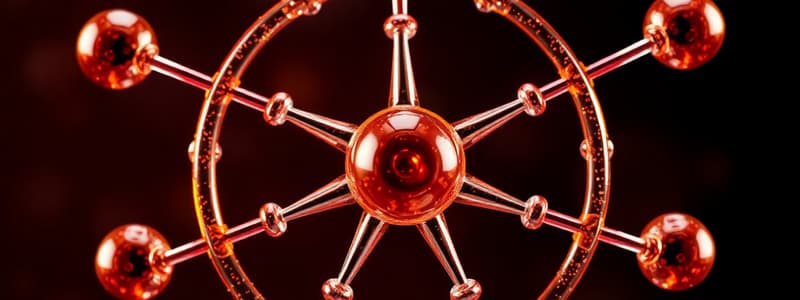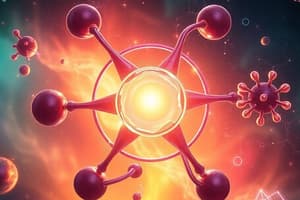Podcast
Questions and Answers
What state are most metals in at room temperature?
What state are most metals in at room temperature?
- Solid (correct)
- Plasma
- Gas
- Liquid
What is the main criterion for arranging elements in the periodic table?
What is the main criterion for arranging elements in the periodic table?
- Mass of electrons
- Color of the elements
- Size of the atoms (correct)
- Mass of neutrons
Which statement accurately reflects the properties of elements in the same group on the periodic table?
Which statement accurately reflects the properties of elements in the same group on the periodic table?
- They have similar chemical properties. (correct)
- They have the same atomic mass.
- They contain the same number of protons.
- They are all gases at room temperature.
What must an atom have to maintain electrical neutrality?
What must an atom have to maintain electrical neutrality?
Which of the following statements about atomic numbers is correct?
Which of the following statements about atomic numbers is correct?
What is an element defined as?
What is an element defined as?
Which term describes a molecule made from two atoms?
Which term describes a molecule made from two atoms?
What information does the periodic table provide about elements?
What information does the periodic table provide about elements?
What is the mass of an atom primarily composed of?
What is the mass of an atom primarily composed of?
Which of the following best describes a monatomic element?
Which of the following best describes a monatomic element?
What characterizes a group in the periodic table?
What characterizes a group in the periodic table?
Why can elements not be broken down further?
Why can elements not be broken down further?
Which of the following best defines an atom?
Which of the following best defines an atom?
Flashcards
Atom
Atom
The smallest particle of matter. It cannot be created, destroyed, or broken down further.
Element
Element
A pure substance made up of only one type of atom.
Monatomic
Monatomic
Consisting of a single atom.
Diatomic
Diatomic
Signup and view all the flashcards
Periodic Table
Periodic Table
Signup and view all the flashcards
Period (Chemistry)
Period (Chemistry)
Signup and view all the flashcards
Group (Chemistry)
Group (Chemistry)
Signup and view all the flashcards
Atomic Number
Atomic Number
Signup and view all the flashcards
Mass Number
Mass Number
Signup and view all the flashcards
Molecule
Molecule
Signup and view all the flashcards
Metals at room temp
Metals at room temp
Signup and view all the flashcards
Non-metals at room temp
Non-metals at room temp
Signup and view all the flashcards
Metal atom structure
Metal atom structure
Signup and view all the flashcards
Periodic Table
Periodic Table
Signup and view all the flashcards
Element Symbol
Element Symbol
Signup and view all the flashcards
Atomic Number
Atomic Number
Signup and view all the flashcards
Atomic Mass
Atomic Mass
Signup and view all the flashcards
Electrically neutral
Electrically neutral
Signup and view all the flashcards
Periodic Table - Periods and Groups
Periodic Table - Periods and Groups
Signup and view all the flashcards
Periodic Table Arrangement
Periodic Table Arrangement
Signup and view all the flashcards
Study Notes
Atoms and Elements
- All matter is made up of atoms.
- An element is a pure substance made of one type of atom.
- The periodic table organizes elements according to their chemical and physical properties.
Atomic Structure
- The atom is the smallest particle of matter.
- It cannot be created, destroyed, or broken down further.
- The nucleus is the central part of the atom, with most of the atom's mass.
- The nucleus consists of positively charged protons and uncharged neutrons.
- Surrounding the nucleus are negatively charged electrons.
Atoms and Elements: Key Terms
- Atom: The smallest particle of matter.
- Element: A pure substance made of only one type of atom.
- Monatomic: Consisting of a single atom.
- Diatomic: A molecule consisting of two atoms.
- Periodic Table: A table that organizes elements based on their atomic number and properties.
- Period: A horizontal row of elements in the periodic table.
- Group: A vertical column of elements in the periodic table.
- Atomic Number: The number of protons in an atom's nucleus.
- Atomic Mass: The average mass of the atoms of that element.
Elements: Properties
- Elements cannot be broken down further.
- All elements have different properties and structures.
- The two main groups of elements are metals and nonmetals.
- Most metals are solid at room temperature and form lattice structures.
- Most nonmetals are gases at room temperature.
The Periodic Table
- Arranges elements based on the size of their atoms.
- All elements are represented by their symbol.
- Symbols use capital letters.
Learning Intentions
- Define and describe the periodic table's key features (periods, groups, etc).
- Relate atomic/mass number to the number of subatomic particles.
More Key Concepts
- Everything on the periodic table is electrically neutral. (Number of protons = Number of electrons.)
- Atomic number is equal to the number of protons.
- Atomic mass is the sum of the number of protons and neutrons.
Additional Details (First 20 Elements)
- You do not need to memorize the names/symbols for all elements for this unit.
- However, knowing the names and symbols of the first 20 elements will be helpful.
- This will help with questions, exercises, and further studies of chemistry concepts.
Studying That Suits You
Use AI to generate personalized quizzes and flashcards to suit your learning preferences.




